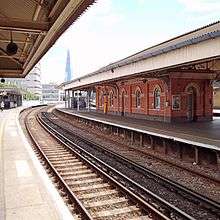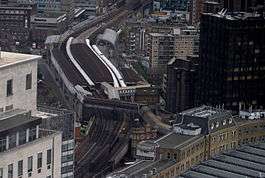London Waterloo East railway station
| Waterloo East | |
|---|---|
| London Waterloo East | |
|
Waterloo East viewed from the London Eye | |
 Waterloo East Location of Waterloo East in Central London | |
| Location | South Bank |
| Local authority | London Borough of Lambeth |
| Grid reference | TQ313800 |
| Managed by | Southeastern |
| Owner | Network Rail |
| Station code | WAE |
| DfT category | B |
| Number of platforms | 4 |
| Fare zone | 1 |
| OSI |
Waterloo (main line) [1] Waterloo (Underground) Embankment Southwark |
| National Rail annual entry and exit | |
| – interchange | 0.812 million[2] |
| 2007–08 |
|
| 2008–09 |
|
| – interchange |
|
| 2010–11 |
|
| – interchange |
|
| 2011–12 |
|
| 2012–13 |
|
| – interchange |
|
| Railway companies | |
| Original company | South Eastern Railway |
| Pre-grouping | South Eastern and Chatham Railway |
| Post-grouping | Southern Railway |
| Key dates | |
| 1 January 1869 | Opened as Waterloo Junction |
| 7 July 1935 | Renamed Waterloo |
| 2 May 1977 | Renamed Waterloo East |
| Other information | |
| Lists of stations | |
| External links | |
| WGS84 | 51°30′13″N 0°06′40″W / 51.5037°N 0.111°WCoordinates: 51°30′13″N 0°06′40″W / 51.5037°N 0.111°W |
|
| |
Waterloo East, also known as London Waterloo East,[3] is a railway station in central London on the line from Charing Cross through London Bridge towards Kent, in the southeast of England. Although Waterloo East is a through-station, it is classed for ticketing purposes as a central London terminus.[4] Services through the station are operated by Southeastern and it is situated within fare zone 1.
An elevated walkway across Waterloo Road connects it to the larger Waterloo station and provides the main access. The eastern ends of Waterloo East's platforms provide pedestrian connection to Southwark station which is served by London Underground's Jubilee line; at street level there is a modest entrance in Sandell Street. Connections with the Underground's Bakerloo, Northern and Waterloo & City lines are available at Waterloo tube station. There is no station building; the ticket office of the main station serves it, though there are ticket machines at the eastern end of the walkway.
The four platforms at Waterloo East are lettered rather than numbered to ensure that staff who work at both Waterloo East and the adjoining Waterloo station, which is managed and branded separately and features numbered platforms, do not confuse the platforms at the two stations. This stratagem is also used for the Thameslink platforms at St. Pancras International and their predecessors at King's Cross Thameslink, as well as at New Cross. Ticket barriers have been installed at the Sandell Street and Southwark station entrances, and also at the main entrance from Waterloo station following the completion of the retail balcony in 2012.
History
_Waterloo_RJD_126.jpg)
The South Eastern Railway opened it as Waterloo Junction in January 1869 to replace Blackfriars Road station which was slightly to the east. The Southern Railway renamed it Waterloo (also known as Waterloo Eastern) in July 1935 and it took its present name in May 1977.
Until 1911[5] a rail connection ran across the concourse of the main station. This saw little service, although H.G. Wells's novel The War of the Worlds describes its use to convey troop trains to the Martian landing site. The bridge which carried the line over Waterloo Road subsequently accommodated the pedestrian walkway between the two stations until replaced by the current high level covered walkway. The old bridge remains and is now used for storage.
Services

All "up" trains run to Charing Cross only, and depart from platforms B and D. All "down" trains run from platforms A and C. The typical off-peak service is:
- 14 trains per hour (tph) Charing Cross
- 2 trains per hour tph Dartford via Bexleyheath
- 2 tph Gravesend via Sidcup
- 2 tph Gillingham via Lewisham and Woolwich Arsenal
- 2 tph Hayes avoiding Lewisham
- 2 tph Sevenoaks via Orpington
- 2 tph Hastings via Tunbridge Wells
- 1 tph Dover via Ashford International
- 1 tph Ramsgate via Ashford International and Canterbury West
Southern also used to operate services at this station, but these were withdrawn in 2009 due to problems with line capacity on the South Eastern Main Line.

Mainline railways around the South Bank | ||||||||||||||||||||||||||||||||||||||||||||||||||||||||||||||||||||||||||||||||||||||||||||||||||||||||||||||||||||||||||||||||||||||||||||||||||||||||||||||||||||||||||||||||||||||||||||||||||||||||||||||||||||||||||||||||||||||||||||||||||||||||
|---|---|---|---|---|---|---|---|---|---|---|---|---|---|---|---|---|---|---|---|---|---|---|---|---|---|---|---|---|---|---|---|---|---|---|---|---|---|---|---|---|---|---|---|---|---|---|---|---|---|---|---|---|---|---|---|---|---|---|---|---|---|---|---|---|---|---|---|---|---|---|---|---|---|---|---|---|---|---|---|---|---|---|---|---|---|---|---|---|---|---|---|---|---|---|---|---|---|---|---|---|---|---|---|---|---|---|---|---|---|---|---|---|---|---|---|---|---|---|---|---|---|---|---|---|---|---|---|---|---|---|---|---|---|---|---|---|---|---|---|---|---|---|---|---|---|---|---|---|---|---|---|---|---|---|---|---|---|---|---|---|---|---|---|---|---|---|---|---|---|---|---|---|---|---|---|---|---|---|---|---|---|---|---|---|---|---|---|---|---|---|---|---|---|---|---|---|---|---|---|---|---|---|---|---|---|---|---|---|---|---|---|---|---|---|---|---|---|---|---|---|---|---|---|---|---|---|---|---|---|---|---|---|---|---|---|---|---|---|---|---|---|---|---|---|---|---|---|---|
Legend | ||||||||||||||||||||||||||||||||||||||||||||||||||||||||||||||||||||||||||||||||||||||||||||||||||||||||||||||||||||||||||||||||||||||||||||||||||||||||||||||||||||||||||||||||||||||||||||||||||||||||||||||||||||||||||||||||||||||||||||||||||||||||
| ||||||||||||||||||||||||||||||||||||||||||||||||||||||||||||||||||||||||||||||||||||||||||||||||||||||||||||||||||||||||||||||||||||||||||||||||||||||||||||||||||||||||||||||||||||||||||||||||||||||||||||||||||||||||||||||||||||||||||||||||||||||||
Connections
London Buses routes 1, 4, 26, 59, 68, 76, 77, 139, 168, 171, 172, 176, 188, 211, 243, 341, 381, 507, 521, RV1 and X68 and night routes N1, N68, N76, N171, N343 and N381 serve the station.
References
- ↑ "Out of Station Interchanges" (XLS). Transport for London. May 2011. Archived from the original on 20 October 2012.
- 1 2 3 4 5 6 7 8 9 "Station usage estimates". Rail statistics. Office of Rail Regulation. Please note: Some methodology may vary year on year.
- ↑ "Station facilities for London Waterloo East". National Rail Enquiries. Retrieved 29 May 2013.
- ↑ "Section A" (PDF). National Fares Manual 98. Association of Train Operating Companies. Retrieved 2 January 2010.
- ↑ Chronology of London Railways by H.V.Borley
External links
| Wikimedia Commons has media related to Waterloo East railway station. |
- Train times and station information for London Waterloo East railway station from National Rail
| Preceding station | |
Following station | ||
|---|---|---|---|---|
| London Charing Cross | Southeastern South Eastern Main Line |
London Bridge | ||
